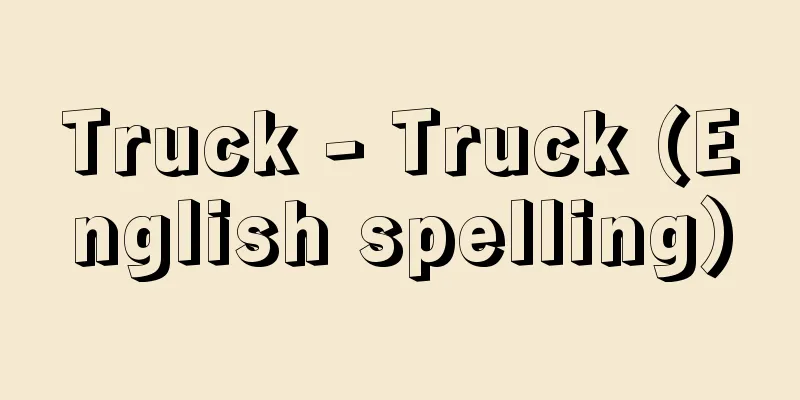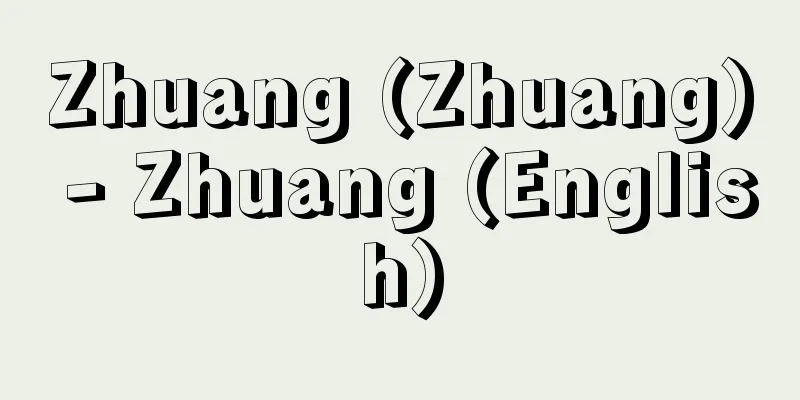Truck - Truck (English spelling)

|
A general term for automobiles used to transport various goods. In Japanese, it is called a freight car. In American English, a truck is called a lorry in English. In German, it is called Lastauto or Lastkraftwagen, but since the word is long, the latter is shortened to LKW. In Latin-speaking countries, it is generally called a camion. [Takashima Shizuo] historyIt dates back to horse-drawn carriages and the oxcarts of the ancient Khmer. The first steam car, built in 1769 by military engineer Cugnot in France, was used to pull artillery carriages and was essentially a truck. Steam trucks were used in Europe for a long time until the 1920s. After the internal combustion engine was put to practical use, Daimler in Germany completed the first gasoline-engine truck in 1896, and Benz succeeded in commercializing diesel trucks in 1923 (Daimler and Benz merged in 1926 to become Daimler-Benz, and in 1998 merged with Chrysler of the United States to become DaimlerChrysler). The current number of trucks and buses in the world is about 187.5 million (1997), and about 15 million are still being produced each year. [Takashima Shizuo] LegislationThere is no specific definition of trucks in the Japanese legal system, but of course there are many regulations and restrictions. Looking at them from each law and government ordinance, first of all, regarding size, the total length must be within 12 meters, the total width within 2.5 meters, and the total height within 3.8 meters. The width and height when loaded must not exceed these limits, and the length only may extend up to one-tenth of the total length of the truck (if it exceeds these limits, a red cloth of 0.3 square meters or more must be attached - a red light or a red reflector at night). The total vehicle weight must be within 20 tons, 10 tons per axle, and 5 tons per wheel. For van-type semi-trailers, the total length must be within 16.5 meters (however, loading that extends beyond the limits is not allowed), and the total vehicle weight must be within 34 tons for those traveling on national expressways, and 27 tons for those traveling on other roads. Any vehicle that exceeds the above restrictions must apply to the administrator of the road on which it is intended to travel, and must travel on a specified route at a specified date and time. A compact car has a total length of 4.7 metres or less, a total width of 1.7 metres or less, a total height of 2 metres or less, a maximum load capacity of 2000 kilograms or less, and a total engine displacement of over 550cc and less than 2000cc. A light car has a total length of 3.2 metres or less, a total width of 1.4 metres or less, a total height of 2 metres or less, a maximum load capacity of 350 kilograms or less, and a total engine displacement of 550cc or less. [Takashima Shizuo] ClassificationIn terms of size, there is an almost seamless range, from the Italian-made Vespa three-wheeled scooter, which is 2.5 meters long and can carry up to 35 kilograms, to the American-made Terex dump truck, which is 20 meters long and can carry up to 317.5 tons. The three-wheeled scooters are used for communication within cities and for delivering small goods, while the huge heavy-duty dump trucks are used for transporting large amounts of rocks, earth and sand at once for large-scale civil engineering works. In terms of use, a wide variety of highly specialized trucks are used today. For a while after the end of World War II, standard trucks with three-sided openings were used to transport all kinds of cargo, but they have gradually been replaced by specialized trucks. The majority of transport trucks are panel vans, which are less susceptible to damage even in bad weather, and medium-sized light vans (vans with windows) are also widely used for small-lot transport and collection and delivery. In addition, there are refrigerated cars, refrigerated cars, live fish transport cars, tank trucks (liquid transport cars), bottle carriers, concrete mixers (transporting ready-mix concrete, ballast, sand, etc. while stirring them), dump trucks, trailer trucks, drum transport cars, container transport cars, bulk trucks (transporting powdered or granular materials), horse transport cars, livestock transport cars, car carriers, art transport cars, cash transport cars, mail cars, etc., and each truck has a shape and structure suited to the object of transport. Recently, there are many self-loaders equipped with self-loading and unloading devices. Garbage trucks and vacuum trucks can also be considered types of trucks with self-loaders. [Takashima Shizuo] structureThe structure of trucks is generally orthodox and simpler than that of passenger cars, but is strong enough to withstand heavy loads. There are a few bonnet-type trucks for rough roads, but most are cab-over engine type trucks that can have a longer loading platform for the same overall length. For large cab-over trucks, the so-called tilt cab is common, in which the cab (driver's compartment) is tilted forward to make engine inspection and maintenance easier. The chassis has an independent ladder frame with rigid axles (small cars often have independent suspension on the front wheels), and semi-elliptical leaf springs are common, although air suspension like that of a bus is not uncommon in Europe and America. A four-wheel drive on two axles is common, but for medium-sized and larger vehicles, twin tires are common on the rear wheels. Many large vehicles have two rear wheels or two front axles, and the basic type is 4x2 with only the rear axles as drive, but there are also 6x2, 6x4, 8x4, and all-wheel drive 4x4 and 6x6. Recently, many vehicles have been designed with smaller wheel diameters on all axles except the rear or first axle, and a low floor to increase luggage capacity and make loading and unloading easier. Diesel engines are the overwhelming majority, except for some small cars and light vehicles, while direct injection engines with high specific power are prevalent in large cars. Many are equipped with turbochargers and intercoolers to boost power output. It is also not uncommon for small cars used for deliveries in cities to run on LPG (liquefied petroleum gas). In large cars, the number of mechanical transmissions that can be operated by fingertips using computers is increasing, and with the spread of power steering and air conditioning, efforts are being made to reduce labor and improve comfort. [Takashima Shizuo] Technical characteristics of truck transportTrucks, along with other land, sea and air transport modes (transport facilities - including pipelines), make up a country's freight transport system. The basic technical characteristic of truck transport is that, although it is a land transport mode, unlike railroads, it does not require tracks (rails). This allows trucks to transport from door to door, and they can provide area-wide transport services rather than linear transport like railroads. Another major feature of truck transport services is that arrival dates and times are more definite and faster than railroads, and this point has recently been given more importance in the industrial sector. The emergence of trucks was initially a technological innovation to replace pre-modern oxcarts, but it continued to be a technological innovation for railroads as well. Based on the characteristics of the transport service described above, trucks have undermined the monopoly of railroads in land freight transport, along with the fall in vehicle prices and the progress of road construction. In most developed countries, including Japan (except the United States), trucks have now established a position as the main land freight transport method, surpassing railroads. [Murao Shita] Japanese TruckingIt is said that the Great Kanto Earthquake of 1923 (Taisho 12) was the catalyst for truck transport to become commercially viable in Japan. However, due to the low level of technology and national income in Japan before World War II, the automobile industry did not take root, and due to the Ministry of Railways' policy of suppressing automobile traffic (both passenger and freight), the wartime shortage of oil fuel, and other reasons, the development of truck transport in Japan was postponed until after the war (in Western countries, it began before the war). Then, after almost completely replacing horse-drawn carts between 1950 and 1955, trucks increased their transport volume by sharing a large share of the increase in land freight amid the rapid increase in domestic freight volume accompanying the high growth of the Japanese economy. Then, in 1966, trucks' share of the transport volume (ton-kilometers) was reversed (with railroads), and by 1972, trucks' share exceeded that of railroads not only for short-distance freight but also for medium-distance and long-distance (over 500 km) freight, and for most land freight items. Thus, it can be said that the motorization of freight transport in Japan was nearly complete by fiscal 1972. Then, in the recession and low growth economy following the oil shock of 1973, truck transport also continued to decline and stagnate, but it recovered in fiscal 1978, and by fiscal 1984 it had increased to 31% above the fiscal 1972 level, and has continued to increase since then. [Murao Shita] Trucking industryPreviously, competition in the trucking industry was limited by entry restrictions, and a national business license was required, but the Trucking Business Act (Law No. 83 of 1989) changed the licensing system to a permit system (except for the light trucking business described below, which requires a notification system) and simplified procedures. Business types are divided into three categories: (1) general trucking business, (2) specific trucking business, and (3) light trucking business. (1) is a business that transports cargo using automobiles (excluding light automobiles with three or more wheels and automobiles with two wheels) in response to the demand of others, for a fee. Among (1), what was previously called general route trucking business operates on fixed routes at fixed times and transports consolidated cargo (small individual cargo items from multiple shippers loaded onto one vehicle) and is called special consolidated cargo transportation. With the enforcement of the new law, the business classifications of general route trucking business and general area trucking business, which were previously only able to do chartered transport, have been integrated, and operators in the old areas are now able to do special consolidation trucking. (2) is a business that transports cargo using automobiles (excluding light automobiles with three or more wheels and two-wheeled automobiles) for a fee in response to the demand of a specific person. (3) is a business that transports cargo using automobiles (limited to light automobiles with three or more wheels and two-wheeled automobiles) for a fee in response to the demand of others. In addition to commercial transport by transport companies, truck transport also accounts for a large proportion of transport by private trucks owned by general factories, stores, etc. Although the proportion of private transport has been gradually decreasing in recent years, it still accounted for approximately 21.6% of truck transport volume (ton-kilometers) in fiscal 1998. Truck freight rates are not free, but are subject to a notified fare system in which operators must notify the Minister of Land, Infrastructure, Transport and Tourism in advance. Any freight rates outside the notified range are illegal, regardless of whether they are high or low, and the Minister of Land, Infrastructure, Transport and Tourism can order changes to unreasonable notified fares. For trucking businesses, roads are publicly provided (part of the road costs are covered in the form of special taxes such as diesel tax and gasoline tax), so businesses can start up with just a few trucks, even with little capital. For this reason, there are many operators, with approximately 52,000 as of 1999 (the majority of these are businesses that do not engage in special consolidated freight transport, as described above in (1)). More than 99% of these are small and medium-sized enterprises (as stipulated in the Small and Medium Enterprise Basic Law) or micro-enterprises. However, among the businesses in (1) above, special consolidated freight transport requires many offices and terminal facilities, so the amount of capital required is relatively large, and the proportion of small and medium-sized enterprises is relatively small. In addition, due to the former Ministry of Transport's policy of restricting licenses for route trucking businesses and encouraging mergers, the number of operators has been gradually decreasing since its peak in 1958 (541 operators), and as of 1999 it was 276 operators. [Murao Shita] IssuesWith so many small and medium-sized companies in the trucking industry, the market is a fierce sales competition. This has resulted in not only discounts on freight rates, but also in the constant practice of overloading trucks beyond the weight limit. In addition, truck parcel services have continued to grow rapidly and have become an integral part of people's lives, but they have also had trouble with customers over freight rates and delivery dates, and in November 1985, the Ministry of Transport approved the "Standard Parcel Service Terms and Conditions" and put into effect. Furthermore, trucking workers (especially drivers) are often forced to work long hours, and hourly wages are about 20% lower than the average for all industries. The development of truck transportation in Japan has advanced logistics and contributed to the establishment and development of the automobile industry and to the realization of high economic growth. However, on the other hand, trucks are becoming the biggest cause of road pollution. Truck exhaust gas, especially nitrogen oxides ( NOx ), is a cause of air pollution, so in order to reduce it, the Automobile Emission Total Emission Reduction Law (officially the Special Measures Law for the Total Emission Reduction of Nitrogen Oxides from Automobiles in Specified Areas, Law No. 70 of 1992) was enacted, and a policy for regulating the total amount of NOx was put forward. In addition, most road noise pollution is caused by trucks and motorcycles. Trucks are now becoming one of the major issues in modern society, including traffic accidents and energy issues. [Murao Shita] "The Automobilization of Freight Transport" by Murao Shigeki (1982, Hakuto Shobo)" ▽ "Road Freight Transport" by Murao Shigeki (1989, Koyo Shobo)" ▽ "Third Edition: Japan's Transportation Problems" edited by Nakanishi Kenichi and Hirooka Haruya (1980, Minerva Shobo)" ▽ "Contemporary Japanese Transportation Industry" edited by Nakanishi Kenichi (1984, Koyo Shobo)" [Reference items] | | | |Source: Shogakukan Encyclopedia Nipponica About Encyclopedia Nipponica Information | Legend |
|
さまざまな物資を輸送するための自動車の総称。日本語では貨物自動車。トラックはアメリカ英語で、英語ではローリーlorryという。ドイツ語ではラストアウトLastautoまたはラストクラフトワーゲンLastkraftwagenだが、長いので後者を短縮してLKWと記す。ラテン語圏では一般にカミオンcamionとよぶ。 [高島鎮雄] 歴史古くは馬車から古代クメールの牛車にまでさかのぼる。1769年にフランスで軍事技術者のキュニョーがつくった史上初の蒸気自動車も砲車牽引(けんいん)用で、いわばトラックであった。その後スチームトラックはヨーロッパで1920年代まで長く使われた。内燃機関が実用化されると、ドイツではダイムラーが1896年に初のガソリンエンジン付きのトラックを完成、1923年にはベンツがディーゼルトラックの市販化に成功した(ダイムラーとベンツは1926年に合併し、ダイムラー・ベンツとなり、さらに98年にアメリカのクライスラーと合併し、ダイムラー・クライスラーとなる)。現在の全世界のトラックおよびバスの保有台数は約1億8750万台(1997)で、なお年々約1500万台が生産されている。 [高島鎮雄] 法制日本の法制度のなかにはとくにトラックを定義している部分はないが、もちろんさまざまな規制や制限は少なくない。それらを各法律や政令から拾ってみると、まず大きさについては全長12メートル以内、全幅2.5メートル以内、全高3.8メートル以内で、積載時の幅と高さはこれを超えてはならず、長さのみはそのトラックの全長の10分の1まではみだしてよい(それを超えるときは0.3平方メートル以上の赤色の布―夜間は赤色灯または赤色反射鏡―をつけること)。車両総重量は20トン以内、1軸10トン以内、1輪5トン以内とする。バン型のセミトレーラーでは全長16.5メートル以内(ただしはみだし積載は不可)、車両総重量は高速自動車国道を通行するものでは34トン以内、その他の道路を通行するものでは27トン以内とされている。以上の制限を超えるものは、通行しようとする道路の管理者に申請し、その指定する日時に、指定するルートを走らなければならない。 なお小型自動車は全長4.7メートル以内、全幅1.7メートル以内、全高2メートル以内、最大積載量2000キログラム以内、エンジン総排気量550cc超2000cc未満、軽自動車は全長3.2メートル以内、全幅1.4メートル以内、全高2メートル以内、最大積載量350キログラム以内、エンジン総排気量550cc以内となっている。 [高島鎮雄] 分類大きさで分ければ、全長2.5メートル、最大積載量35キログラムのイタリア製ベスパ三輪スクーターから、全長20メートル、317.5トン積みのアメリカ製テレックス・ダンプトラックまで、ほとんど無段階に分布している。三輪スクーターは都市内での連絡や小型商品の配達用などであり、巨大型重量級ダンプトラックは大規模な土木工事で一度に大量の岩石や土砂などを運ぶためである。 用途別には、今日では高度に専門化された多様のトラックが使用されている。第二次世界大戦の終了後しばらくの間、あらゆる種類の荷物の運搬に使用されていた三方開きあおり付きの標準型トラックはしだいに専用トラックに席を譲ってきている。輸送用トラックの主力は悪天候にも荷傷みの少ないパネルバンが占めており、小口の輸送や集配には中型のライトバン(窓付きバン)も多用されている。このほか冷凍車、保冷車、活魚運搬車、タンクローリー(液体運搬車)、ボトル・キャリアー、コンクリートミキサー(生コンクリート、バラスト、砂などを攪拌(かくはん)しながら運ぶ)、ダンプトラック、トレーラートラック、ドラム缶輸送車、コンテナ輸送車、バルクトラック(粉体や果粒状のものを運ぶ)、馬匹運搬車、家畜運搬車、カーキャリアー、美術品輸送車、現金輸送車、郵便車などがあり、それぞれの輸送対象に適した形態構造をもっている。最近ではセルフローダーと称し、自身積み下ろしの装置を備えたものも少なくない。ごみ収集車やバキュームカーもセルフローダー付きのトラックの一種とすることができる。 [高島鎮雄] 構造トラックの構造は概してオーソドックスで乗用車に比べれば単純だが、重荷重に耐えるように十分な強度を与えられる。悪路用としてボンネット型のものも少数あるが、大半は同じ全長なら長い荷台をとれるキャブオーバーエンジン型式を採用している。大型のキャブオーバーでは、キャブ(運転室)を前傾させてエンジンの点検整備を容易にした、いわゆるチルトキャブが一般的である。 シャシーは独立したはしご形フレームにリジッドアクスルをもち(小型車の前輪には独立懸架も少なくない)、半楕円(だえん)板ばねが一般的だが、ヨーロッパやアメリカではバスなみのエアサスペンションも珍しくない。車輪配置は二軸四輪が一般的だが、中型以上では後輪をダブルタイヤとするのが普通である。大型には後二輪や前二軸のものも少なくなく、駆動は後軸のみの4×2を基本に、6×2、6×4、8×4、総輪駆動の4×4、6×6などがある。最近では後輪ないしは第一軸以外の車輪径を小さくし、低床式として荷物室容積を増やし、かつ積み下ろしを容易にしたものも少なくない。 エンジンは小型車の一部と軽自動車を除いてはディーゼルが圧倒的で、大型では比出力の高い直接噴射式が普及している。ターボチャージャーやインタークーラーを備えて出力増強を図ったものも少なくない。また都市内で配達などに使われる小型車にはLPG(液化石油ガス)を用いるものも珍しくない。大型車では機械式変速機をコンピュータにより指先で操作できるようにしたものが増えつつあり、パワーステアリングやエアコンの普及とともに、省力化や居住性の向上が図られている。 [高島鎮雄] トラック輸送の技術的特性トラックは、ほかの陸海空の輸送手段(交通機関――パイプラインを含む)とともに、一国の貨物輸送体系を構成する。トラック輸送の技術的特性の基本は、陸上輸送手段でありながら鉄道と異なり軌道(レール)を必要としないことである。このためトラックは戸口から戸口へ(door to door)の輸送が可能となり、鉄道のように線的な輸送でなく、面的な輸送サービスを供給することができる。トラック輸送サービスはまた、鉄道に比べて到着日時が明確でかつ早いことが大きな特色となっており、この点が最近は産業界でいっそう重視されるようになってきた。トラックの出現は、当初は前近代的な荷牛馬車にとってかわる技術革新であったが、それは引き続き鉄道に対する技術革新ともなっていった。 トラックは前記のような輸送サービスの特性を基礎に、車両価格の低下、道路整備の進展に伴い、それまでの鉄道による陸運貨物輸送の独占を掘り崩していった。そして日本を含むほとんどの先進諸国(アメリカを除く)において、いまでは鉄道をしのぐ主要な陸運貨物輸送手段としての地位を確立している。 [村尾 質] 日本のトラック輸送日本でトラック輸送が営業として成立するようになるのは、1923年(大正12)の関東大震災が契機になったといわれる。しかし、第二次世界大戦前には日本の技術および国民所得水準の低さから自動車工業が確立しなかったことや、鉄道省による自動車交通(貨客とも)抑圧政策、また戦時の石油燃料不足その他の理由によって、日本のトラック輸送の発展は戦後に持ち越された(欧米諸国では戦前に開始)。そして1950年(昭和25)から55年ごろまでの間に荷牛馬車をほぼ完全に駆逐したのち、日本経済の高成長に伴う国内貨物量の急激な増大のなかで、トラックは陸運貨物の増加量の大部分を分担する形で、その輸送量を増大させていった。そして1966年度には輸送量(トンキロ)に占める比重を(鉄道と)逆転させ、72年度ごろには短距離貨物だけでなく中距離および長距離(500キロメートル以上)でも、またほとんどの陸運貨物品目で鉄道を超える比重をもつようになった。こうして1972年度段階には、日本の貨物輸送自動車化(モータリゼーション)はほぼ完成したといえる。そして1973年のオイル・ショック後の不況と低成長経済のもとで、トラック輸送も減少と停滞を続けたが、78年度には回復し、84年度には72年度水準を31%超えるまでに増大し、以後増加を続けている。 [村尾 質] トラック運送業トラック運送業は従来参入規制により競争が制限され、国の事業免許を必要としていたが、貨物自動車運送事業法(平成1年法律83号)によって、免許制から許可制になったほか(ただし後述の貨物軽自動車運送事業は届出制)、手続き等の簡素化がはかられた。事業の種類は、(1)一般貨物自動車運送事業、(2)特定貨物自動車運送事業、(3)貨物軽自動車運送事業の3種に区分される。(1)は他人の需要に応じ、有償で自動車(三輪以上の軽自動車および二輪の自動車を除く)を使用して貨物を運送する事業である。(1)のうち、従来は一般路線貨物自動車運送事業とよばれたもので、定路線を定時に運行し、積合せ貨物(一車に複数荷主の小口個品貨物を積み合わせて運ぶ)を運送するものを特別積合せ貨物運送という。新法施行により、一般路線貨物自動車運送事業と、従来は貸切り運送しかできなかった一般区域貨物自動車運送事業の事業区分が一体化され、旧区域の事業者も特別積合せ貨物運送ができることになった。(2)は特定の者の需要に応じ、有償で自動車(三輪以上の軽自動車および二輪の自動車を除く)を使用して貨物を運送する事業である。(3)は他人の需要に応じ、有償で自動車(三輪以上の軽自動車および二輪の自動車に限る)を使用して貨物を運送する事業である。 トラック輸送には、運送業者による営業用輸送のほか、一般の工場・商店などの保有する自家用トラックによる輸送の比重も大きい。自家用輸送の比重は近年徐々に低下しつつあるとはいえ、1998年度(平成10)のトラック輸送量(トンキロ)に占める比重は約21.6%である。 トラック運賃は自由運賃でなく、事業者があらかじめ国土交通大臣に届け出る、届出運賃制がとられている。届出外の運賃は高くても安くても違法となり、また、不当な届出運賃に対しては国土交通大臣が変更を命じることができる。 トラック運送業にとって道路は公共的に提供されている(道路費の一部を軽油引取税、揮発油税などの特別税の形で負担)から、トラック数台さえもてば営業できるので、小資本でも開業できる。このため事業者数は多く、1999年現在で約5万2000業者を数える(その大部分は前記(1)のうち特別積合せ貨物運送を行わない業者)。その99%以上が中小企業(中小企業基本法の規定による)もしくは零細業者である。ただし、前記(1)のうち、特別積合せ貨物運送業は多くの営業所やターミナル施設などを必要とするため、必要資金量が比較的大きく、中小企業の比重は相対的に小さい。また旧運輸省が路線トラック業への免許抑制・合併奨励政策を行っていたことによって、業者数は1958年度(541業者)をピークとして漸減を続け、1999年現在には276業者となっている。 [村尾 質] 問題点トラック運送業界にはこのように多数の中小・零細企業が存在するから、市場は激しい売り込み競争となっている。このため運賃値引きのほか、制限重量を超える過積載が後を絶たない。また、急成長を続け、国民生活に密着したものとなってきているトラック宅配便について、運賃、引渡し期日などをめぐって利用者との間にトラブルも生じており、1985年(昭和60)11月、運輸省認可による「標準宅配便約款」が施行された。なお、トラック運送業労働者(とくに運転者)は長時間労働を強いられる場合が多く、実労働時間当り賃金は全産業平均より2割ほど低くなっている。 日本におけるトラック輸送の発展は、物流を高度化し、一面では自動車工業の確立・発展、ひいては高経済成長の実現にも寄与してきた。しかし他面では、道路公害の最大の原因者となりつつある。トラックの排ガス、とくに窒素酸化物(NOx)については、大気汚染の原因物質であることから、その削減のために1992年(平成4)に自動車排出窒素酸化物総量削減法(正式名は、自動車から排出される窒素酸化物の特定地域における総量の削減等に関する特別措置法。平成4年法律70号)が施行され、NOxの総量規制の方針などが打ち出されているところである。また道路騒音公害の原因はほとんどトラックと二輪車によるものである。そのほか交通事故、エネルギー問題をも含めて、トラックはいまや現代社会の重要な問題点の一つとなりつつある。 [村尾 質] 『村尾質著『貨物輸送の自動車化』(1982・白桃書房)』▽『村尾質著『道路貨物輸送』(1989・晃洋書房)』▽『中西健一・廣岡治哉編著『三版 日本の交通問題』(1980・ミネルヴァ書房)』▽『中西健一編『現代日本の交通産業』(1984・晃洋書房)』 [参照項目] | | | |出典 小学館 日本大百科全書(ニッポニカ)日本大百科全書(ニッポニカ)について 情報 | 凡例 |
<<: Drugstore - Drugstore (English name)
Recommend
Prohibition of ex post facto laws
This principle states that a newly enacted law (e...
Hiyoshi [village] - Hiyoshi
A village in Kiso County, southwest of Nagano Pref...
(R)I Su‐gwang
1563‐1628 A Korean civil servant and scholar of pr...
ODA Outline - ODA Outline
...However, in the 1980s, the trend toward "...
Pugwash
A village in Nova Scotia, southeastern Canada. Loc...
Lambert's law
…The attenuation constant of absorption in a medi...
Uranium-lead method - uranium-lead method
A method of determining the age of rocks that util...
Basic Law on Agriculture - Kihon Hounousei
…The development of Japan's agricultural poli...
The Road to Space Flight
…Although his research was not recognized as fant...
Marine ranch
A future technology system that uses large areas ...
Omonoimi no Kami - Omonoimi no Kami
The deity enshrined at Omonoimi Shrine in Dewa Pro...
soarer
...Large gliders were developed for transporting ...
Edwards, Jonathan
Born October 5, 1703 in East Windsor, Connecticut ...
Paper noodles - Kamimenko
…This was the first metal toy to become popular a...
Daikyoin - Daikyoin
It was the central organization of the Meiji gove...









